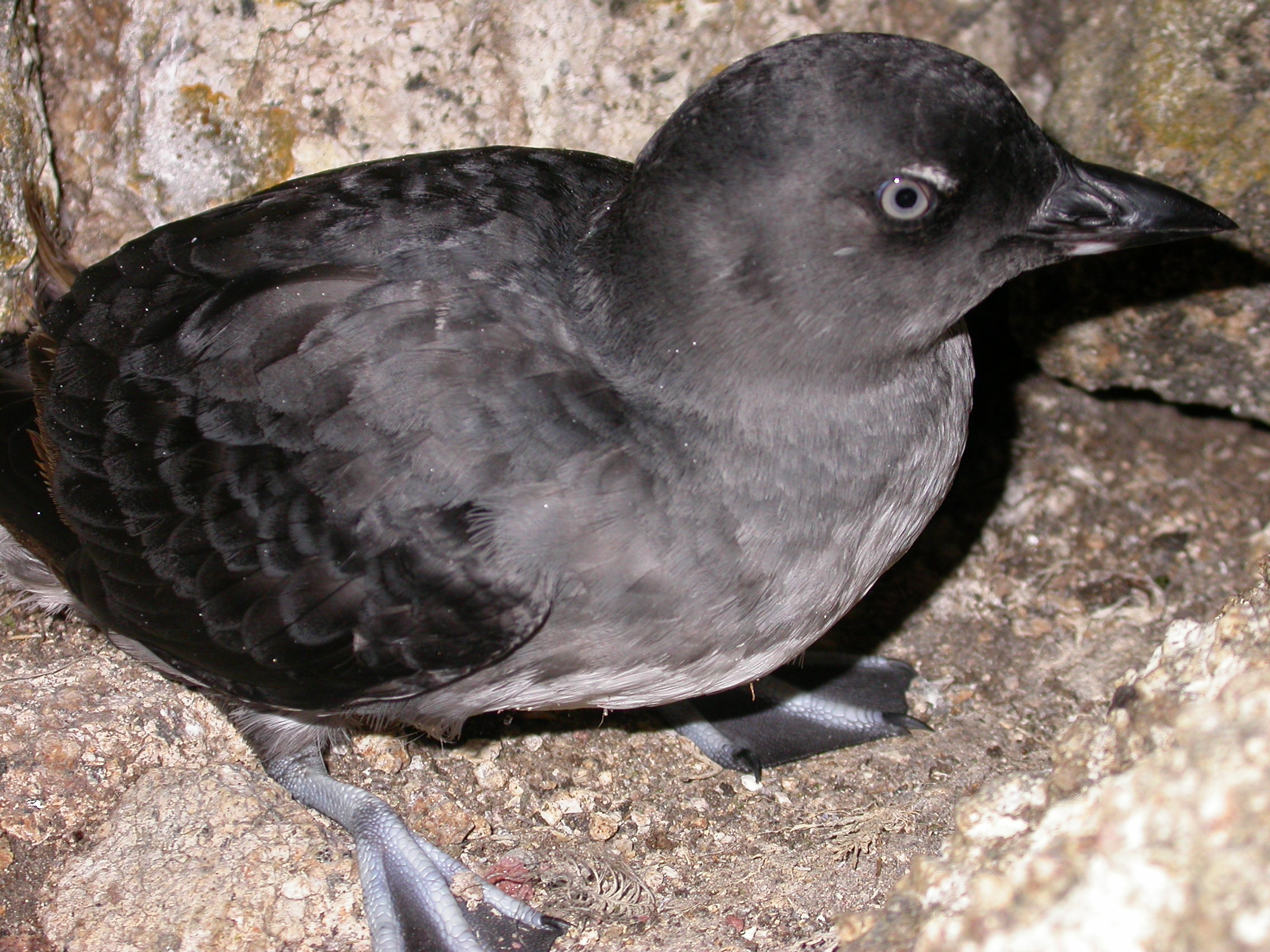- Cassin's Auklet
Taxobox
name = Cassin’s Auklet
status = LC | status_system = IUCN3.1

image_width = 250px
regnum =Animal ia
phylum = Chordata
classis = Aves
ordo =Charadriiformes
familia =Alcidae
genus = "Ptychoramphus"
genus_authority = Brandt 1837
species = "P. aleuticus"
binomial = "Ptychoramphus aleuticus"
binomial_authority = (Pallas,1811 )The Cassin’s Auklet, "Ptychoramphus aleuticus", is a small, chunky
seabird that ranges widely in theNorth Pacific . It nests in small burrows and because of its presence on well studiedisland s inBritish Columbia and offCalifornia it is one of the better knownauk s. It is named forJohn Cassin , aPennsylvania businessman and naturalist.The Cassin's Auklet is a small (25 cm, 200 g) nondescript auk. Its
plumage is generally dark above and pale below, with a small white mark above the eye. Its bill is overall dark with a pale spot, and its feet are blue. Unlike many other auks the Cassin's Auklet lacks dramaticbreed ing plumage, remaining the same over most of the year. At sea it is usually identified by its flight, which is described as looking like a flyingtennis ball.The Cassin's Auklet ranges from midway up theBaja California peninsula toAlaska 'sAleutian Islands , offNorth America . It nests on offshore islands, with the main population stronghold beingTriangle Island offVancouver Island 's Cape Scott, where the population is estimated to be around 550,000 pairs. It is not known to be migratory, however northern birds may move farther south during the winter.An extinct relative or predecessor species, "Ptychoramphus tenuis", is known from the Late
Pliocene of theSan Diego Formation inCalifornia .Behaviour
The Cassin's Auklet nests in burrows on small islands, and in the southern area of its range may be found in the breeding colony year round. It either digs holes in the soil or uses natural cracks and crevices to nest in, also readily using man-made structures. Pairs will show a strong loyalty towards each other and to a nesting site for many years. Both the parents
incubate the single white egg, returning to swap shifts at night to avoid being taken by predators such as theWestern Gull orPeregrine Falcon . The egg is incubated for 40 days, the small chick is then fed nightly for 35 days by both parents, who bring regurgitated food in a specialgular pouch , often referred to in the literature as asublingual pouch . The chickfledge s alone and makes its way to the sea. The Cassin's Auklet is unusual amongst seabirds in occasionally laying a second clutch after a successful first clutch (it is the only northern hemisphere seabird to do so).At sea Cassin's Auklets feeds offshore, in clear often
pelagic water, often associating with bathymetric landmarks such asunderwater canyon s andupwelling s. It feeds by diving underwater beating its wings for propulsion, hunting down largezooplankton , especiallykrill . It can dive to 30 m below the surface, and by some estimates 80 m.Conservation
The Cassin's Auklet is listed as Least Concern; although some populations (principally the
Farallon Islands population) have suffered steep declines, overall the species is still numerous. Threats to the auklet include introduced carnivores (particularly in Alaska),oil spill s and changes insea surface temperature (caused byEl Niño events). The Cassin’s Auklet is protected under theMigratory Bird Treaty Act of 1918 . [http://www.fws.gov/migratorybirds/intrnltr/mbta/mbtandx.html]References
* Database entry includes justification for why this species is of least concern
*Manuwal, D. A. and A. C. Thoresen. 1993. Cassin’s Auklet ("Ptychoramphus aleuticus"). "In" The Birds of North America, No. 50 (A. Poole and F. Gill, Eds.). Philadelphia: The Academy of Natural Sciences; Washington, D.C.: The American Ornithologists’ Union.External links
* [http://vireo.acnatsci.org/search.html?Form=Search&SEARCHBY=Common&KEYWORDS=cassin%27s+auklet&showwhat=images&AGE=All&SEX=All&ACT=All&Search=Search&VIEW=All&ORIENTATION=All&RESULTS=24 Cassin's Auklet photo gallery] VIREO
Wikimedia Foundation. 2010.
